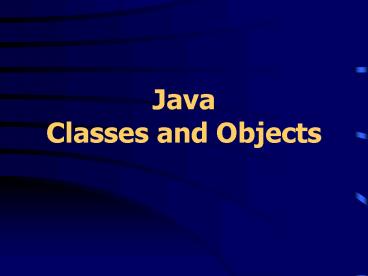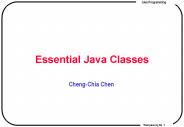Java Classes and Objects - PowerPoint PPT Presentation
1 / 37
Title:
Java Classes and Objects
Description:
Method overloading is Java's polymorphic behavior. Method ... However, in some cases the match need not be exact because of Java's automatic type conversions. ... – PowerPoint PPT presentation
Number of Views:1454
Avg rating:3.0/5.0
Title: Java Classes and Objects
1
Java Classes and Objects
2
Classes
- The basic element of object-oriented programming
object in Java is a class. - A class defines the structure (instance
variables) of an object and its functional
interface (methods). - Once a Java program is running, the system uses
class definitions to create instances (objects)
of classes.
3
Classes
- To define a class, use the class keyword and the
name of the class - class MyClassName
- class-body
4
Classes
- The body of the class
- type instance-variable1
- type instance-variable2
- ...
- type instance-variableN
- type methodname1(parameter-list)
method-body - type methodname2(parameter-list)
method-body - ...
- type methodnameN(parameter-list)
method-body
5
Subclasses
- If this class is a subclass of another specific
class - class myClassName extends mySuperClassName
- When a class declaration does not contain an
extends clause, the class is automatically made a
subclass of the Object class.
6
Dot (.) Operator
- The dot(.) operator is used to access the
instance variables and methods within an object. - Objectname.variablename
- objectname.method(parameter-list)
7
new Operator
- The new operator creates single instance of a
named class and returns a reference to that
object. - Classvariable objectreference new classname()
8
new Operator
- The statement actually is composed of two parts
- (1) Classvariable objectreference declares an
object reference to an object of the class type.
(the object has a null value) - (2) objectreference new classname() allocates
memory for the object and assign the reference to
the object. - (OnePoint.java, TwoPoints.java, Class1.java)
9
Constructor
- The ( ) in the new statement specifies the
constructor for the class. - A constructor defines what occurs when an object
of a class is created. - A constructor is a method which initializes an
object immediately upon creation. - Constructors have no return type and void.
10
Constructor
- Most real-world classes explicitly define their
own constructors within their class definition. - If no constructor is specified, Java will
automatically supply a default constructor. - (ClassInit2.java and ClassInit3.java)
11
Object Reference Variables
- Class1 c1 new Class1( )
- Class1 c2 c1
- c1 null
- Both c1 and c2 refer to the same original object.
- After c1 is set to null, c2 still point to the
original object.
12
Instance Variables
- Data is encapsulated in a class by declaring
variables inside of the of the class
declaration. - Instance variables are declared the same way as
the local variables are declared. - Instance variables are declared outside of the
scope any method in the class.
13
Methods
- type methodname1(parameter-list)
method-body - Type specifies the type of data returned by the
method. - If the method does not return a value, its return
type must be void. - Methods that have return type other than void
return a value to the calling routine using the
the return statement - return value.
14
Methods
- The parameter-list is a sequence of type and
identifier pairs separated by comma. They are
arguments passed to the the method when it is
called. - A method dose not have to have a parameter-list.
15
Methods
- When an instance variable is accessed by code
that is not part of the class, it must be done
through an object, by using the dot operator. - If the instance variable is accessed by code that
is part of the same class, that variable can be
referred to directly. - (ClassMethod1, 2, 3.java ClassTestStack.java)
16
Method Overloading
- It is possible to define two or more methods
within the same class using the same name, as
long as each parameter declaration (not return
type) is unique. - When this happens, the methods are said to be
overloaded, and the process is called
overloading. - Method overloading is Javas polymorphic behavior.
17
Method Overloading
- When an overloaded method is invoked, Java uses
the type and/or the number of the parameters as
the guide to determine which version of the
overloaded method to be called. - However, in some cases the match need not be
exact because of Javas automatic type
conversions. - (MethodOverloading1, 2, 3. Java)
18
Overloading Constructors
- Like regular methods, constructors can also take
varying numbers and types of parameters, enabling
you to create your object with exactly the
properties you want it to have, or for it to be
able to calculate properties from different kinds
of input. - (ConstructorOverloading1, 2, 3.java)
19
Objects as Parameters
- It is common to construct a new object so that it
is initially the same as some existing object. - To do this, define a constructor function that
takes an object of its class as a parameter. - (ConstructorOverloading4.java)
20
Return Objects
- A method can return any type of data, including
class types that you create. - Since all objects are dynamically allocated using
new, the object will continue to exist even the
method in which it was created terminates. - (ReturningObject1.java)
21
Argument Passing
- Call-by-value. A value (of a simple type) is
passed to the parameter of the method. - Call-by-reference. A reference (of an object) to
an argument is passed to the parameter of the
method. - (ArgumentPassing1, 2.java)
22
Recursion
- Recursion is the process of defining something in
terms of itself. - It allows a method to call itself.
- A recursive call does not make a new copy of the
method. Only the parameter is different.
23
Recursion
- Recursive versions of many routines may execute a
bit more slowly than the iterative equivalent
because of the added overhead of the additional
function calls. - The main advantage is that recursion can be used
to create clearer and simpler versions of the
algorithms. - (Recursion1.java)
24
Access Control
- Through encapsulation, you can control what
members of a Java class can be accessed by other
parts of the program. - The access specifiers determine the
accessibility. - Javas access spedifiers are public, private, and
protected.
25
Access Control
- Public specifies that the member can be accessed
by any other code in a Java program. The main()
is a typical example. - Private specifies that the member can only be
accessed by the other members of the class. - Protected applies only when inheritance is
involved.
26
Access Control
- Usually, you will want to restrict access to the
data members of a class - allowing access only
through methods. - The general form
- accessspecifier variablename/methodname
- (AccessControl1.java)
27
static
- Define a class member to be used independently of
any object of that class. - Create a class member that can be used by itself,
without any reference to a specific instance. - When a member is declared static, it can be
accessed before any objects of its class are
created. The main() method is a typical example.
28
static
- Instance variables declared as static are
essentially global variables. - Methods declared as static
- (1) can only call other static methods,
- (2) must only access static data,
- (3) cannot refer to this or super.
- (StaticClass 1, 2.java)
29
main()
- The main() method is the first thing that a Java
application gets called. The form is - public static void main(String args )
- Public means that this method is available to
other classes and objects. - Static means that this is a class method.
30
main()
- Void means that the main() method doesnt return
anything. - The main() method takes one parameter an array
of strings. This argument is used for
command-line arguments. - (MainMethod.java)
31
super
- Whenever a subclass needs to refer to its
immediate superclass, it can do so by use of the
keyword super. - Super must always be used as the first statement
inside a subclass constructor. - (Inheritance1.java)
32
Inheritance in Multilevel Hierarchy
- You can build class hierarchies that contain as
many as layers of inheritance as you like. - Constructors in the multilevel hierarchy are
called in order of derivation, from superclass to
subclass. - (InheritanceMultilevel.1)
33
Method Overriding
- In a class hierarchy, when a method in a subclass
has the same name and type signature as a method
in its superclass, the method is the subclass is
said to override the method in the superclass. - The version of the method defined by the
superclass will be hidden.
34
Method Overriding
- To access the superclass version of the
overridden method, use the keyword super. - Method overriding occurs only when the names and
type signatures are identical. If they are not,
then the two methods are simply overloaded. - (MethodOverriding1, 2, 3, 4.java)
35
Dynamic Method Dispatch
- If a superclass contains a method that is
overridden by a subclass, then different versions
of the method are executed based on the type of
the object being referred at the time the call
occurs. - This happens at run-time and is called Javas
implementation of run-time polymorphism.
(DynamicMethodDispatch1.java)
36
final
- The final modifier is used when you do not want a
method or an instance variable to be overridden. - It is common to choose all uppercase identifiers
for final variables or methods. - You can also declare a class final to prevent the
class from being inherited.
37
abstract
- Sometimes you want to create an abstract
superclass that only defines a generalized form
that will be shared by all of its subclasses,
leaving it to each subclass to implement what is
needed. - Any class which contains any methods declared
abstract must also be declared abstract.































